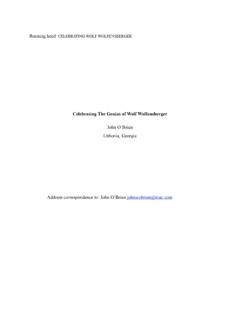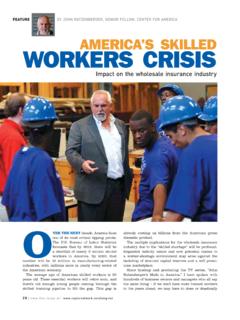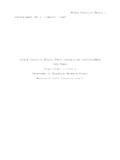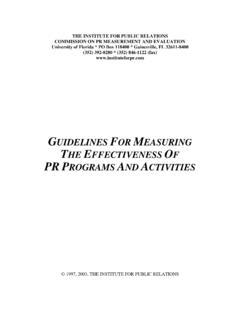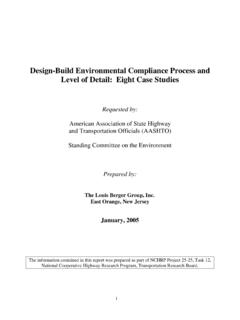Transcription of IEEE Std 450 450TM EEE Standards IEEE Standards
1 IEEE Std 450 -2002. (Revision of IEEE Std 450-1995). 450 TM. IEEE Standards IEEE Recommended Practice for Maintenance, Testing, and Replacement of Vented Lead-Acid Batteries for Stationary Applications IEEE Power Engineering Society Sponsored by the PES Stationary Battery Committee Published by The Institute of Electrical and Electronics Engineers, Inc. 3 Park Avenue, New York, NY 10016-5997, USA. Print: SH95063. 3 April 2003 PDF: SS95063. IEEE Std 450 -2002. (Revision of IEEE Std 450-1995). IEEE Recommended Practice for Maintenance, Testing, and Replacement of Vented Lead-Acid Batteries for Stationary Applications Sponsor PES Stationary Battery Committee of the IEEE Power Engineering Society Approved 9 December 2002.
2 IEEE-SA Standards Board Abstract: Maintenance, test schedules, and testing procedures that can be used to optimize the life and performance of permanently installed, vented lead-acid storage batteries used for standby power applications are provided. This recommended practice also provides guidance to determine when batteries should be replaced. This recommended practice is applicable to full-float stationary applications where a charger maintains the battery fully charged and supplies the dc loads. Keywords: acceptance test, battery capacity, battery installation, battery maintenance, battery replacement criteria, battery service test, battery terminal voltage, connection resistance measure- ments, electrolyte level, equalize charge, float voltage, modified performance test, performance test, service test, specific gravity, standby power applications, state of charge, test-discharge rate, vented lead-acid battery The Institute of Electrical and Electronics Engineers, Inc.
3 3 Park Avenue, New York, NY 10016-5997, USA. Copyright 2003 by the Institute of Electrical and Electronics Engineers, Inc. All rights reserved. Published 3 April 2003. Printed in the United States of America . IEEE is a registered trademark in the Patent & Trademark Office, owned by the Institute of Electrical and Electronics Engineers, Incorporated. Print: ISBN 0-7381-3491-0 SH95063. PDF: ISBN 0-7381-3492-9 SS95063. No part of this publication may be reproduced in any form, in an electronic retrieval system or otherwise, without the prior written permission of the publisher.
4 IEEE Standards documents are developed within the IEEE Societies and the Standards Coordinating Committees of the IEEE Standards Association (IEEE-SA) Standards Board. The IEEE develops its Standards through a consensus develop- ment process, approved by the American National Standards Institute, which brings together volunteers representing varied viewpoints and interests to achieve the nal product. Volunteers are not necessarily members of the Institute and serve with- out compensation. While the IEEE administers the process and establishes rules to promote fairness in the consensus devel- opment process, the IEEE does not independently evaluate, test, or verify the accuracy of any of the information contained in its Standards .
5 Use of an IEEE Standard is wholly voluntary. The IEEE disclaims liability for any personal injury, property or other dam- age, of any nature whatsoever, whether special, indirect, consequential, or compensatory, directly or indirectly resulting from the publication, use of, or reliance upon this, or any other IEEE Standard document. The IEEE does not warrant or represent the accuracy or content of the material contained herein, and expressly disclaims any express or implied warranty, including any implied warranty of merchantability or tness for a speci c purpose, or that the use of the material contained herein is free from patent infringement.
6 IEEE Standards documents are supplied AS IS.. The existence of an IEEE Standard does not imply that there are no other ways to produce, test, measure, purchase, market, or provide other goods and services related to the scope of the IEEE Standard. Furthermore, the viewpoint expressed at the time a standard is approved and issued is subject to change brought about through developments in the state of the art and comments received from users of the standard. Every IEEE Standard is subjected to review at least every ve years for revi- sion or reaf rmation.
7 When a document is more than ve years old and has not been reaf rmed, it is reasonable to conclude that its contents, although still of some value, do not wholly re ect the present state of the art. Users are cautioned to check to determine that they have the latest edition of any IEEE Standard. In publishing and making this document available, the IEEE is not suggesting or rendering professional or other services for, or on behalf of, any person or entity. Nor is the IEEE undertaking to perform any duty owed by any other person or entity to another.
8 Any person utilizing this, and any other IEEE Standards document, should rely upon the advice of a com- petent professional in determining the exercise of reasonable care in any given circumstances. Interpretations: Occasionally questions may arise regarding the meaning of portions of Standards as they relate to speci c applications. When the need for interpretations is brought to the attention of IEEE, the Institute will initiate action to prepare appropriate responses. Since IEEE Standards represent a consensus of concerned interests, it is important to ensure that any interpretation has also received the concurrence of a balance of interests.
9 For this reason, IEEE and the members of its soci- eties and Standards Coordinating Committees are not able to provide an instant response to interpretation requests except in those cases where the matter has previously received formal consideration. Comments for revision of IEEE Standards are welcome from any interested party, regardless of membership af liation with IEEE. Suggestions for changes in documents should be in the form of a proposed change of text, together with appropriate supporting comments. Comments on Standards and requests for interpretations should be addressed to: Secretary, IEEE-SA Standards Board 445 Hoes Lane Box 1331.
10 Piscataway, NJ 08855-1331. USA. Note: Attention is called to the possibility that implementation of this standard may require use of subject mat- ter covered by patent rights. By publication of this standard, no position is taken with respect to the existence or validity of any patent rights in connection therewith. The IEEE shall not be responsible for identifying patents for which a license may be required by an IEEE standard or for conducting inquiries into the legal validity or scope of those patents that are brought to its attention.
